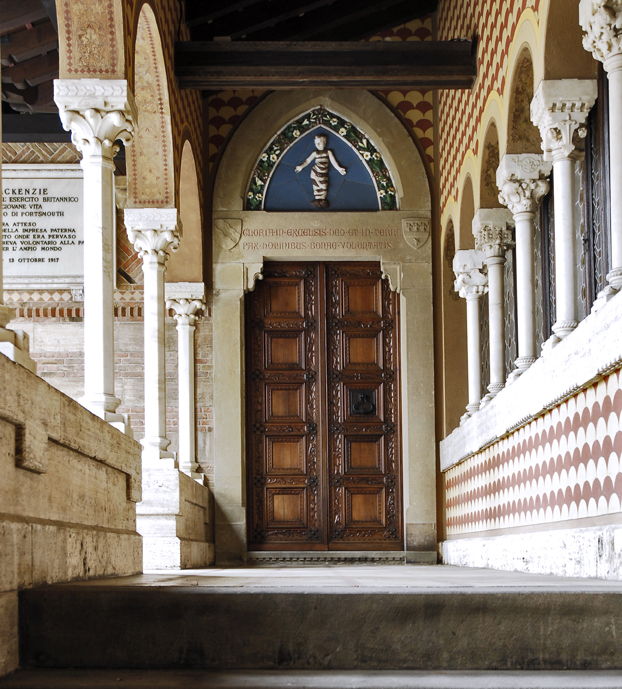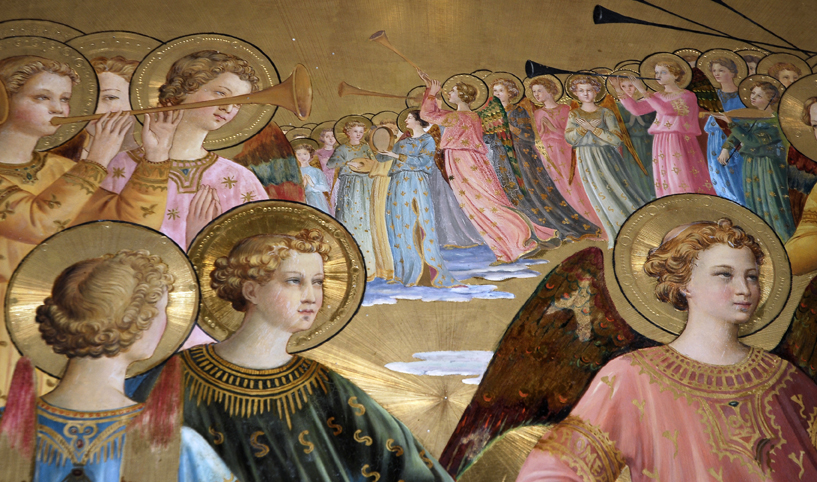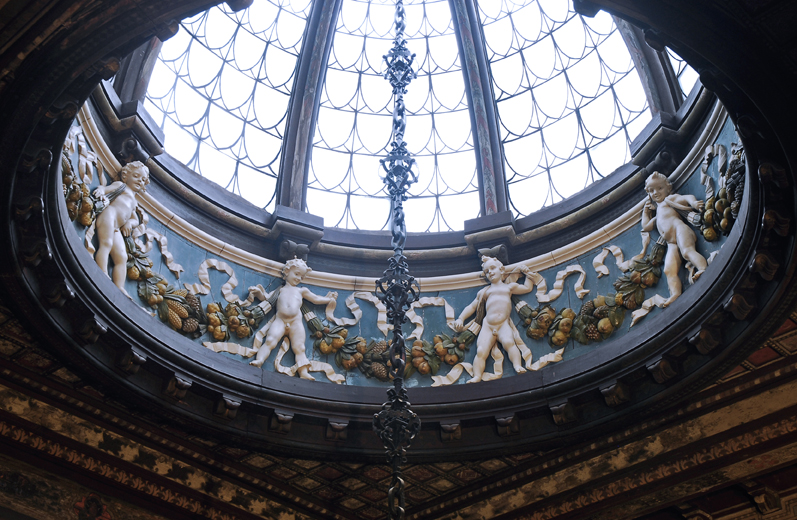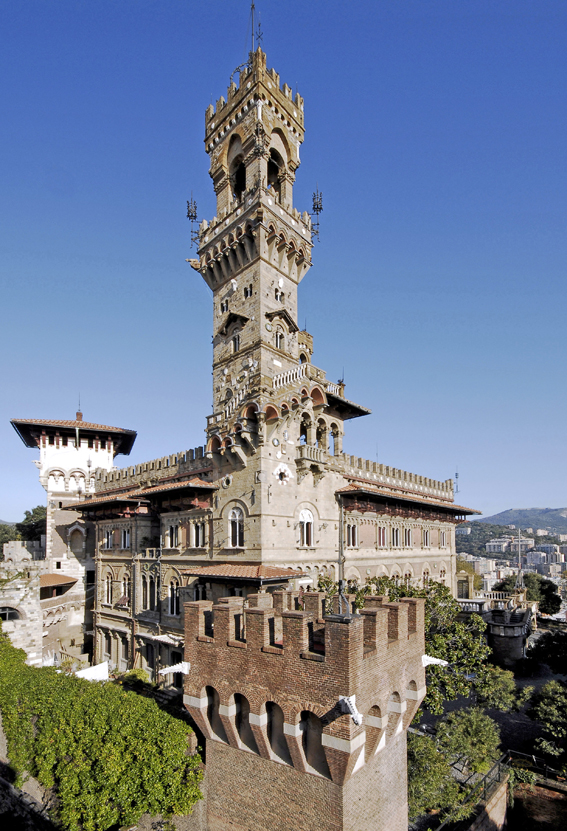Next to the 17th-century walls of the San Bartolomeo’s rampart, Castello Mackenzie stands with all its complex architectonic structure – delimited by a surrounding wall crenellated with towers, external stairs and patrol routes – on the hill going towards piazza Manin.
The building, as it is today, is the result of the restoration of a pre-existing building, carried out between the end of the 19th and the beginning of the 20th century by Gino Coppedè on behalf of the Scottish insurer Evan Mackenzie. The Castle is the debut work and masterpiece of the young architect, who, creating this complex, used the main elements of its cultural and artistic training. This intervention is the result of a consistent work of restyling on the pre-existing 17th-century villa. So, Coppedè revised the original structure, realizing a series of attractive spaces, as the cloister and the artificial caves, organized through a series of spectacular inventions – small towers, drawbridges and walkways – connected to the new volume assigned to host the monumental hall and the marble grand-staircase.
As far as the decorations of the Castle, Coppedè peculiar attitude to easily combine formal models from the past with direct references to the contemporary artistic culture is, to some extent, revealed by the famous sentence he pronounced at the end of the works: “I fiddle around with it.” His ironic design approach, as it was repeatedly highlighted, did not represent the effect of a strong philological path, as it can be seen in the recalling of past styles that inspired the theoretical and operational principles by Pugin, Ruskin, Morris and Viollet-le-Duc. Coppedè received his training in the second half of the 19th century, in an environment characterized by a widespread arbitrariness of interpretation of historical models, not only in the architectonical field, but also in the artistic and literary ones. In Coppedè research, it is worth mentioning the presence of a taste for assemblage and for free stylistic contamination.
Such unrestrained attitude to connect different suggestions coming from a wide and eclectic repertoire of ornamental motifs, represented the main architect expressive peculiarity: a stylistic prerogative that Rossana Bossaglia – who first started a serious and analytic study on the Coppedès, in a period still sceptic and hostile towards these artistic phenomena – defined “epidermis architecture.” And in fact, it is no accident that Mario Labò – in his text presenting the collection of paintings Castelli e ville in carattere quattrocentesco di Gino Coppedè (1914) – highlighted, with these words, how the main characteristic of his designing activity was represented by an inborn predisposition at modelling the plastic surface of the architectonic manufactures: “… this Prato citizen… feels with deep honesty and love the ancient wonderful art that marked so hard and grave traces in his homeland Tuscany. He feels it in his own personal way: he accepts the main points and then he embellishes them with attentive care, decorating the massive and squared plans with projections, creating with grey stone and dark vermilion brick a complexity and vagueness of styles which are sufficient to brighten and cheer the nude and rude severity of the warrior volume; in this way, the ancient phantom dresses up with new shapes and breathes a new soul. In this change, the architect joins, and to some extent overtops, the sculptor – Gino Coppedè came from a family of excellent carvers, and had in his hands the mark left from chisels and gouges – and the abundance of images increases until the space can contain them.”
The “Coppedè style” became known right through this aesthetic and operative code, style which became a current and popular definition, sometimes with a negative meaning, up to these days. But this “Coppedè style” was a definition already ascribed to the peak of the success of the young architect’s career, as shown in these considerations by a journalist of that time: “The style? There is only one answer to this question. Coppedè Style. He takes good where he finds it, and combines the best of the various schools in a fusion that definitely belongs to him… perhaps ornaments are overabundant, but excess is one of Coppedè characteristics. He wants to give his artist work and to fix in the raw, but obedient material, the exuberant energy of restless and jovial man.”
If this superficial interpretation of “Coppedè style” had, and to some extent, keeps on having a confirmation in common opinion, the most recent critical comments on Gino’s and his family’s activity – starting from the famous research by Bossaglia of 1982, I Coppedè – showed its groundlessness, underlining how the longevity of these expressive features was determined by a direct and updated comparison with the main architectonic and artistic trends of the time. Among the main modernist trends that featured the cultural panorama between the 19th and 20th century, Gino Coppedè looked in particular at a certain secessionist monumentalism, absorbing the fundamental design models and the most relevant iconographic themes.
Even if he did not completely subscribe to a modernist classicism, whose simplification contributed the passage from brickwork to reinforced concrete, from Otto Wagner’s school Coppedè took the capacity of leaving the 19th-century historicism. The recall to Wagner’s and his pupil Leopold Bauer’s projects is especially evident in his personal reworking of the secessionist taste for the mausoleum: a demonstration of cultural opening that included also references to the renewal in architecture of the large northern European cities and to the “Opéra style” by Charles Garnier, who worked in the south of France, where he built the Casinò in Montecarlo (1878–1879), and in Liguria, where he built his own villa in Bordighera in 1870.
Expressive contiguity with the formal Middle-European models, introduced in Italy also by the suggestions inspired by Peter Behrens’ work for the German section of the “Esposizione Internazionale di Arte Decorativa Moderna” in Turin in 1902, can be noticed also in his personal taste for sculptures decorating the façades of his buildings: a formal feature – largely developed on the occasion of the huge stagy work for the “Esposizione Internazionale di Marina, Igiene marinara e Mostra coloniale italiana” in Genoa in 1914 – used also by his brother Adolfo, as showed by the two heads next to the entrance of the Palazzina Antonini, built in Florence in 1907.
Getting back to the specific example of Castello Mackenzie, Coppedè cultural harmony with Evan Mackenzie was fundamental for his design approach. Probably they met for the first time in 1890 in Florence, in the antique shop of the sculptor Pasquale Romanelli. They both loved the “Florence style” established during the 19th century and developed until the first years of the 20th century through an idealistic vision of the Tuscan traditional production, that became the main depositary of the Renaissance and Medieval tradition. A cultural fellowship that, thanks to the theatre Coppedè taste, comes out in their double portrait in the centre of the anachronistic and scenographic vision of the construction site of the Castle, depicted in the mural painting along the flight of the entrance grand staircase.
This particular artistic context, developed within a variegated production in the fields of cabinet making, ceramics, wrought iron and alabaster, played a fundamental role in designing decorations and furnishings of Castello Mackenzie. Among the main Tuscan manufactures involved, under the planning direction of Coppedès “La Casa Artistica”, it is necessary to remember Cantagalli and De Matteis in Florence and Officine Michelucci in Pistoia.
In the Castle, Ulisse Cantagalli’s manufacture, that with a production inspired to the 16th-century artistic tradition had already had a primary role in the decorations of Castello Stibbert in Florence, proposed again his interpretations of the Renaissance typologies and of the Della Robbia’s repertoire. In particular, it is worth mentioning, in the access courtyard to the Chapel, the relief earthenware figure at the centre of the lunette of the portal: reproduction of one of Andrea Della Robbia’s putti, placed in the centre of the tondos on the façade of the Spedale degli Innocenti in Florence.
Even the cooperation with Officina De Matteis – “Impresa per la costruzione di artistiche vetrate medievali”, established in Florence in 1859 by Ulisse De Matteis and Natale Bruschi – highlighted in the decorative works of Castello Mackenzie a complete harmony with the stylistic mix expressed by Coppedè architectonic project. Among the various glass windows it is possible to notice – in the two mullioned windows with two lights above the altar of the Chapel with the Saints Michele and Liberato Martire – a stylistic similitude with the taste of the pictorial decorations of the space, inspired to the figurative lesson from Beato Angelico, in an overall recall to Tuscan culture of the end of Medieval period and 15th century.
As for the participation of the Officine Michelucci to the construction of the Castle, where they were called to realize metallic and wrought iron decorations, together with the firms Mantero in Genova, Pinasco in Recco and Checcucci in San Gimignano, it is worth mentioning that their cooperation with the Coppedès had already started on early 1890s.
If the main style characteristic of the Castle expresses a bundle of reminders to the Tuscan artistic tradition and, in particular, to formal and iconographic 15th and 16th-century models, Mackenzie Castle decorations are full of references to linguistic themes of modern decorative art, which, at that time, was becoming popular in Italy, through the suggestions coming from the different international interpretations of Art Nouveau.
Mackenzie – who was involved in the social and cultural context of his time, thanks to his direct participation to public life through his entrepreneurial activity and his role of collector and promoter of decorative arts – was able to adapt his taste also to the most innovative stylistic trends. His cultural opening to artistic trends, apparently far from his own interests is attested by the overdoor stuccos in his bedroom (probably prior to Coppedè intervention), representing Allegorie delle stagioni and Le età della vita, replicating the original marble tondos by the neoclassical Danish sculptor Bertel Thorvaldsen.
Among the decorations of the Castle inspired by the new style, probably the most striking example is the marble bas-relief, from Bistolfi, Il viandante e la fonte that the Ligurian sculptor Edoardo De Albertis carved in 1901, the same year in which he gave a significant contribution to the “VII Esposizione Regionale Industriale” in Genoa. A clear reference to the secessionist art nouveau figurative culture can be found also in the mosaic placed on the external façade of the Castle and realized by the Società Musiva in Venice.
In other cases, the formal and iconographic models of the new style are reworked through a more direct recall to the late medieval and renaissance culture, such as in the mural paintings by Gino’s brother, Carlo, representing an important part of the decorations of Castello Mackenzie and sanctioning the affirmation of an artistic style that characterized the subsequent realizations of the Coppedès. In these particular pictorial decorations, it is also noticed the tastes and the cultural interests of the client, as it is clear not only in the already mentioned representation of the Castle construction site, but also in the mural painting representing the opening of the Banco di San Giorgio and in the self-celebration of the renaissance procession, where the various members of the family are portrayed with costumes of the time.
The building, as it is today, is the result of the restoration of a pre-existing building, carried out between the end of the 19th and the beginning of the 20th century by Gino Coppedè on behalf of the Scottish insurer Evan Mackenzie. The Castle is the debut work and masterpiece of the young architect, who, creating this complex, used the main elements of its cultural and artistic training. This intervention is the result of a consistent work of restyling on the pre-existing 17th-century villa. So, Coppedè revised the original structure, realizing a series of attractive spaces, as the cloister and the artificial caves, organized through a series of spectacular inventions – small towers, drawbridges and walkways – connected to the new volume assigned to host the monumental hall and the marble grand-staircase.
As far as the decorations of the Castle, Coppedè peculiar attitude to easily combine formal models from the past with direct references to the contemporary artistic culture is, to some extent, revealed by the famous sentence he pronounced at the end of the works: “I fiddle around with it.” His ironic design approach, as it was repeatedly highlighted, did not represent the effect of a strong philological path, as it can be seen in the recalling of past styles that inspired the theoretical and operational principles by Pugin, Ruskin, Morris and Viollet-le-Duc. Coppedè received his training in the second half of the 19th century, in an environment characterized by a widespread arbitrariness of interpretation of historical models, not only in the architectonical field, but also in the artistic and literary ones. In Coppedè research, it is worth mentioning the presence of a taste for assemblage and for free stylistic contamination.
Such unrestrained attitude to connect different suggestions coming from a wide and eclectic repertoire of ornamental motifs, represented the main architect expressive peculiarity: a stylistic prerogative that Rossana Bossaglia – who first started a serious and analytic study on the Coppedès, in a period still sceptic and hostile towards these artistic phenomena – defined “epidermis architecture.” And in fact, it is no accident that Mario Labò – in his text presenting the collection of paintings Castelli e ville in carattere quattrocentesco di Gino Coppedè (1914) – highlighted, with these words, how the main characteristic of his designing activity was represented by an inborn predisposition at modelling the plastic surface of the architectonic manufactures: “… this Prato citizen… feels with deep honesty and love the ancient wonderful art that marked so hard and grave traces in his homeland Tuscany. He feels it in his own personal way: he accepts the main points and then he embellishes them with attentive care, decorating the massive and squared plans with projections, creating with grey stone and dark vermilion brick a complexity and vagueness of styles which are sufficient to brighten and cheer the nude and rude severity of the warrior volume; in this way, the ancient phantom dresses up with new shapes and breathes a new soul. In this change, the architect joins, and to some extent overtops, the sculptor – Gino Coppedè came from a family of excellent carvers, and had in his hands the mark left from chisels and gouges – and the abundance of images increases until the space can contain them.”
The “Coppedè style” became known right through this aesthetic and operative code, style which became a current and popular definition, sometimes with a negative meaning, up to these days. But this “Coppedè style” was a definition already ascribed to the peak of the success of the young architect’s career, as shown in these considerations by a journalist of that time: “The style? There is only one answer to this question. Coppedè Style. He takes good where he finds it, and combines the best of the various schools in a fusion that definitely belongs to him… perhaps ornaments are overabundant, but excess is one of Coppedè characteristics. He wants to give his artist work and to fix in the raw, but obedient material, the exuberant energy of restless and jovial man.”
If this superficial interpretation of “Coppedè style” had, and to some extent, keeps on having a confirmation in common opinion, the most recent critical comments on Gino’s and his family’s activity – starting from the famous research by Bossaglia of 1982, I Coppedè – showed its groundlessness, underlining how the longevity of these expressive features was determined by a direct and updated comparison with the main architectonic and artistic trends of the time. Among the main modernist trends that featured the cultural panorama between the 19th and 20th century, Gino Coppedè looked in particular at a certain secessionist monumentalism, absorbing the fundamental design models and the most relevant iconographic themes.
Even if he did not completely subscribe to a modernist classicism, whose simplification contributed the passage from brickwork to reinforced concrete, from Otto Wagner’s school Coppedè took the capacity of leaving the 19th-century historicism. The recall to Wagner’s and his pupil Leopold Bauer’s projects is especially evident in his personal reworking of the secessionist taste for the mausoleum: a demonstration of cultural opening that included also references to the renewal in architecture of the large northern European cities and to the “Opéra style” by Charles Garnier, who worked in the south of France, where he built the Casinò in Montecarlo (1878–1879), and in Liguria, where he built his own villa in Bordighera in 1870.
Expressive contiguity with the formal Middle-European models, introduced in Italy also by the suggestions inspired by Peter Behrens’ work for the German section of the “Esposizione Internazionale di Arte Decorativa Moderna” in Turin in 1902, can be noticed also in his personal taste for sculptures decorating the façades of his buildings: a formal feature – largely developed on the occasion of the huge stagy work for the “Esposizione Internazionale di Marina, Igiene marinara e Mostra coloniale italiana” in Genoa in 1914 – used also by his brother Adolfo, as showed by the two heads next to the entrance of the Palazzina Antonini, built in Florence in 1907.
Getting back to the specific example of Castello Mackenzie, Coppedè cultural harmony with Evan Mackenzie was fundamental for his design approach. Probably they met for the first time in 1890 in Florence, in the antique shop of the sculptor Pasquale Romanelli. They both loved the “Florence style” established during the 19th century and developed until the first years of the 20th century through an idealistic vision of the Tuscan traditional production, that became the main depositary of the Renaissance and Medieval tradition. A cultural fellowship that, thanks to the theatre Coppedè taste, comes out in their double portrait in the centre of the anachronistic and scenographic vision of the construction site of the Castle, depicted in the mural painting along the flight of the entrance grand staircase.
This particular artistic context, developed within a variegated production in the fields of cabinet making, ceramics, wrought iron and alabaster, played a fundamental role in designing decorations and furnishings of Castello Mackenzie. Among the main Tuscan manufactures involved, under the planning direction of Coppedès “La Casa Artistica”, it is necessary to remember Cantagalli and De Matteis in Florence and Officine Michelucci in Pistoia.
In the Castle, Ulisse Cantagalli’s manufacture, that with a production inspired to the 16th-century artistic tradition had already had a primary role in the decorations of Castello Stibbert in Florence, proposed again his interpretations of the Renaissance typologies and of the Della Robbia’s repertoire. In particular, it is worth mentioning, in the access courtyard to the Chapel, the relief earthenware figure at the centre of the lunette of the portal: reproduction of one of Andrea Della Robbia’s putti, placed in the centre of the tondos on the façade of the Spedale degli Innocenti in Florence.
Even the cooperation with Officina De Matteis – “Impresa per la costruzione di artistiche vetrate medievali”, established in Florence in 1859 by Ulisse De Matteis and Natale Bruschi – highlighted in the decorative works of Castello Mackenzie a complete harmony with the stylistic mix expressed by Coppedè architectonic project. Among the various glass windows it is possible to notice – in the two mullioned windows with two lights above the altar of the Chapel with the Saints Michele and Liberato Martire – a stylistic similitude with the taste of the pictorial decorations of the space, inspired to the figurative lesson from Beato Angelico, in an overall recall to Tuscan culture of the end of Medieval period and 15th century.
As for the participation of the Officine Michelucci to the construction of the Castle, where they were called to realize metallic and wrought iron decorations, together with the firms Mantero in Genova, Pinasco in Recco and Checcucci in San Gimignano, it is worth mentioning that their cooperation with the Coppedès had already started on early 1890s.
If the main style characteristic of the Castle expresses a bundle of reminders to the Tuscan artistic tradition and, in particular, to formal and iconographic 15th and 16th-century models, Mackenzie Castle decorations are full of references to linguistic themes of modern decorative art, which, at that time, was becoming popular in Italy, through the suggestions coming from the different international interpretations of Art Nouveau.
Mackenzie – who was involved in the social and cultural context of his time, thanks to his direct participation to public life through his entrepreneurial activity and his role of collector and promoter of decorative arts – was able to adapt his taste also to the most innovative stylistic trends. His cultural opening to artistic trends, apparently far from his own interests is attested by the overdoor stuccos in his bedroom (probably prior to Coppedè intervention), representing Allegorie delle stagioni and Le età della vita, replicating the original marble tondos by the neoclassical Danish sculptor Bertel Thorvaldsen.
Among the decorations of the Castle inspired by the new style, probably the most striking example is the marble bas-relief, from Bistolfi, Il viandante e la fonte that the Ligurian sculptor Edoardo De Albertis carved in 1901, the same year in which he gave a significant contribution to the “VII Esposizione Regionale Industriale” in Genoa. A clear reference to the secessionist art nouveau figurative culture can be found also in the mosaic placed on the external façade of the Castle and realized by the Società Musiva in Venice.
In other cases, the formal and iconographic models of the new style are reworked through a more direct recall to the late medieval and renaissance culture, such as in the mural paintings by Gino’s brother, Carlo, representing an important part of the decorations of Castello Mackenzie and sanctioning the affirmation of an artistic style that characterized the subsequent realizations of the Coppedès. In these particular pictorial decorations, it is also noticed the tastes and the cultural interests of the client, as it is clear not only in the already mentioned representation of the Castle construction site, but also in the mural painting representing the opening of the Banco di San Giorgio and in the self-celebration of the renaissance procession, where the various members of the family are portrayed with costumes of the time.



